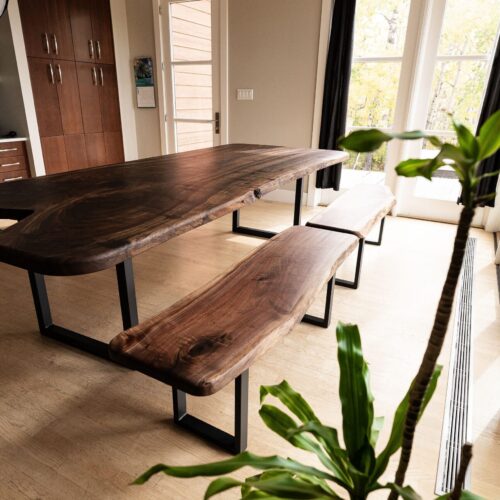Crafting a custom dining table has never been easier. Our dining table size guide allows you to create a piece that perfectly reflects your style and fits perfectly into your home.
This guide will take you through everything you need to know about custom dining table size, dimensions, and the process of creating your dream table.
Finding the Perfect Fit: Dining Table Size and Dimensions
A perfectly sized dining table isn’t just about aesthetics; it’s about functionality and comfort. An oversized table might look impressive, but it can create a cramped feeling and make conversation difficult. On the other hand, a table that’s too small leaves guests feeling squished and unable to spread out their elbows.
Here’s where understanding dining table dimensions comes in:
- Standard Dining Table Heights: Most dining tables are between 28-30 inches (71-76 centimeters) tall. This height is designed to complement standard dining chair seat heights, which typically range from 17-19 inches (43-48 centimeters) from the floor. This allows for comfortable legroom beneath the table for diners of average height. If you are planning on using custom chairs or benches, be sure to factor in their seat height to ensure proper legroom. Aim for at least 9-12 inches (23-30 centimeters) of clearance between the underside of the tabletop or lowest point of the table and the chair seat for optimal comfort.
- Space per Person: Aim for 24 inches (61 centimeters) of table width per person for a basic fit, but ideally, shoot for 28-30 inches (71-76 centimeters) for a more comfortable dining experience.
- Standard Table Widths: Standard dining tabletops typically range from 36-42 inches (91-107 centimeters) in width. This range offers a good balance between providing enough space for diners and ensuring the table isn’t too wide for comfortable conversation across it. However, if you have your heart set on a table outside of this range, consider these guidelines:
- Wider than 42 inches (107 centimeters): While it can provide a more luxurious feel and ample space for serving dishes and centerpieces, a table wider than 42 inches might make reaching across the table for conversation awkward, especially for guests seated opposite each other. It’s also important to ensure doorways and hallways are wide enough to accommodate the table comfortably.
- Narrower than 36 inches (91 centimeters): While a space-saving option, tables narrower than 36 inches can feel cramped. Especially if you use large plates or have a lot of serving dishes. If you choose a narrower table, be mindful of plate size and consider having fewer centerpieces to avoid feeling cluttered.
Let’s Measure Up: Calculating the Right Table Size for Your Space
Now that you have some basic guidelines, it’s time to translate them into your specific needs. Here’s how to calculate the ideal custom dining table size for your space:
- Measure Your Dining Room: Grab a tape measure and determine the length and width of your dining area in feet and inches (or meters and centimeters). For example, if your dining room is 10 feet 6 inches long (3.2 meters) and 8 feet 3 inches wide (2.5 meters), record these dimensions.
- Leave Room to Move: Here’s the magic formula: subtract 3 feet (1.07 meters) from both the length and width of your dining space. This ensures enough clearance for chairs to be pulled in and out comfortably, and allows for easy movement around the table.
- Consider Chair Size: Factor in the size of your dining chairs when calculating space. Most standard dining chairs are around 18-20 inches (46-51 centimeters) wide.
Example: Let’s say your dining room measures 12 feet (3.6 meters) by 10 feet (3 meters). Following the formula, subtract 3 feet from each dimension (12 ft – 3 ft = 9 ft; 10 ft – 3 ft = 7 ft). This leaves you with a recommended maximum table size of 9 feet by 7 feet (2.74 meters by 2.13 meters).
Shape Up! Choosing the Right Table Shape for Your Space
Now that you have a rough idea of the size, consider the shape that best compliments your space and needs:
- Rectangular Tables:
- Good for: Rectangular tables are a classic choice and work well in long, narrow rooms. They offer plenty of seating along the length of the table.
- Standard Sizes:
- For seating 4 people: Approximately 36 inches (91 centimeters) wide by 60 inches (152 centimeters) long.
- For seating 6 people: Around 36 inches (91 centimeters) wide by 72 inches (183 centimeters) long.
- For seating 8 people: About 36 inches (91 centimeters) wide by 96 inches (244 centimeters) long.
- Round Tables:
- Good for: Round tables are great for fostering conversation and creating a more intimate setting. They are ideal for square rooms where a centralized focus is desired.
- Standard Sizes:
- For seating 4 people: Approximately 36 inches (91 centimeters) in diameter.
- For seating 6 people: Around 48 inches (122 centimeters) in diameter.
- For seating 8 people: About 60 inches (152 centimeters) in diameter.
- Oval Tables:
- Good for: Oval tables offer the benefits of both rectangular and round shapes. They provide ample seating without feeling cramped and work well in various room shapes.
- Standard Sizes:
- For seating 4 people: Approximately 36 inches (91 centimeters) wide by 60 inches (152 centimeters) long.
- For seating 6 people: Around 36 inches (91 centimeters) wide by 72 inches (183 centimeters) long.
- For seating 8 people: About 42 inches (107 centimeters) wide by 84 inches (213 centimeters) long.
Beyond Size: Additional Factors to Consider
While size is crucial, there are other considerations when choosing a custom dining table:
- Number of Guests: How many people do you typically need to seat? Consider both everyday use and larger gatherings if you’re an entertainer.
- Table Base Style: Pedestal bases, trestle bases, or 4 post legs there are many leg options available. Each style has their own set of unique characteristics that can enhance a space and the functionality of the table. consider the leg style’s impact on seating and legroom.
- Style and Design: Think about the overall style and design of your dining area and home decor. Choose a table that harmonizes with the existing style, whether it’s modern, rustic, traditional, or eclectic.
- Leaf Options: If you need to accommodate extra guests occasionally, consider a table with a built-in or separate leaves that extends its length.
- Budget: Your budget will play a significant role in determining the type and size of dining table you will be able to afford.
- Accessibility: Think about how the table will get to its final destination. Are there stairs, tight corners, or narrow doorways that might pose a challenge? Knowing the access path beforehand will help ensure your dream table arrives smoothly.
- Maintenance Requirements: Different materials and types of finishes require varying levels of maintenance. Consider how much time and effort you’re willing to invest in cleaning and maintaining your dining table. Especially if you have young children or pets.
- Environmental Impact: If sustainability is important to you, research the materials and manufacturing processes used to create the dining table. Opt for eco-friendly options such as urban logged lumber, or sustainably sourced wood when possible. At Stone Mountain Projects we love using locally sourced lumber.
- Future Plans: Think about your future plans for the dining area. Will you be staying in your current home long term, or do you anticipate moving in the near future? Choose a dining table that fits your current lifestyle while also considering its flexibility to adapt to future changes.
Conclusion
You’ve now mastered the essentials of choosing the ideal dining table size with our comprehensive guide. Armed with our dining table size guide, you’re ready to craft the perfect custom table tailored to your needs and space. Thank you for investing your time with us and please check out our other posts on wood choices for your next project and care and maintenance of your new table.
Have a beauty day!
Harley Chief sawdust maker at Stone Mountain Projects

